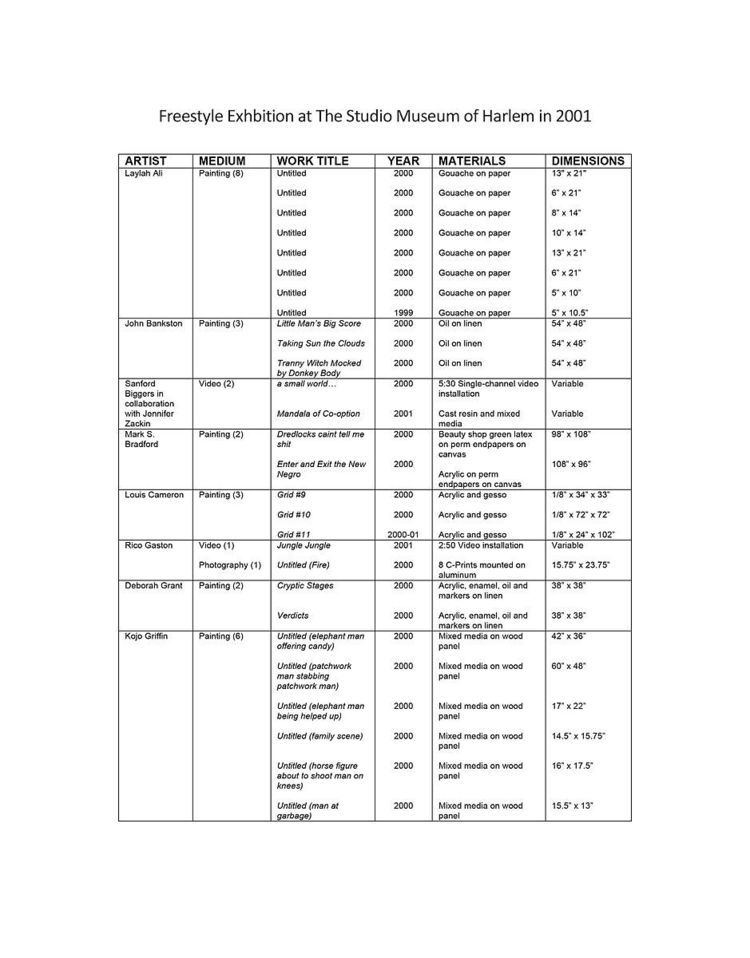 | ||
The Freestyle exhibition was a contemporary exhibition at The Studio Museum of Harlem from April 28-June 24, 2001 curated by Thelma Golden with the support of curatorial assistant Christine Y. Kim. Golden curated the works of 28 emerging black artists for the exhibition, characterizing the work as ‘Post-Black’. The latter is a term she generated along with artist Glenn Ligon as a genre of art “that had ideological and chronological dimensions and repercussions. It was characterized by artists who were adamant about not being labeled as 'black' artists, though their work was steeped, in fact deeply interested, in redefining complex notions of blackness." Freestyle was her first major project at The Studio Museum in Harlem and the first of four ‘F’ themed series of exhibitions including Frequency, Flow and Fore.
Contents
Background
At the time of the exhibition, Thelma Golden had recently resigned from a position at the Whitney as their first black curator, accepting the position of deputy director at The Studio Museum of Harlem (SMH) during a time of renovation for the museum. Ten years prior to her new role at the SMH, she had worked as a curatorial intern for the same museum. Golden credits her time at the Whitney Museum working on the 1993 Whitney Biennial as: “my curatorial education really on every level: my education about working with artists, my education about commissioning work, my education about understanding the museum context, my education about the notion of audience and how it operates”. She also curated the Whitney’s 1994 Black Male exhibition, thinking of the black male as a subject through the works of a multi-cultural roster of artists and the 1998 Bob Thompson exhibition, which she described as being “the first major survey of a mid-century African-American artist in a long time.”
Golden selected "Freestyle" artists based on the quality of her studio visits and her resonance with the artists themselves, referring to herself as someone who deals with artists pushing the definition of American art rather than someone who deals with objects. Her vision for The Studio Museum in Harlem was a place where-in exhibitions would allow space for critique and questions to be explored. Golden was particularly interested in exploring how black artists could shape a contemporary blackness after the activism of the 60’s, the essentialist Black Arts Movement of the 70’s, the theoretical multiculturalism of the 80’s and global expansion of the late 90’s. The work that followed revealed a prevailing theme of black individuality, reflecting Golden’s understanding of the exhibition title, referring to ‘freestyle’ as “the term which refers to the space where the musician (improvisation) or...the dancer (the break) finds the groove and goes all out in a relentless and unbridled expression of the self.” The exhibition was funded by Philip Morris Companies, INC, the Peter Norton Family Foundation and the exhibition fund: Jacqueline Bradley & Clarence Otis, Fifth Floor Foundation and Joel Shappiro.
Works
The artmakers of "Freestyle" experimented with digital media and sound as well as culture-specific materials like hair pomade and curling papers to explore social, political, sexual and ethnic issues. From painting and drawing to sculpture, installation and new media, the work reveals the artists' exposure to both Eastern and Western thought. Some works included:
